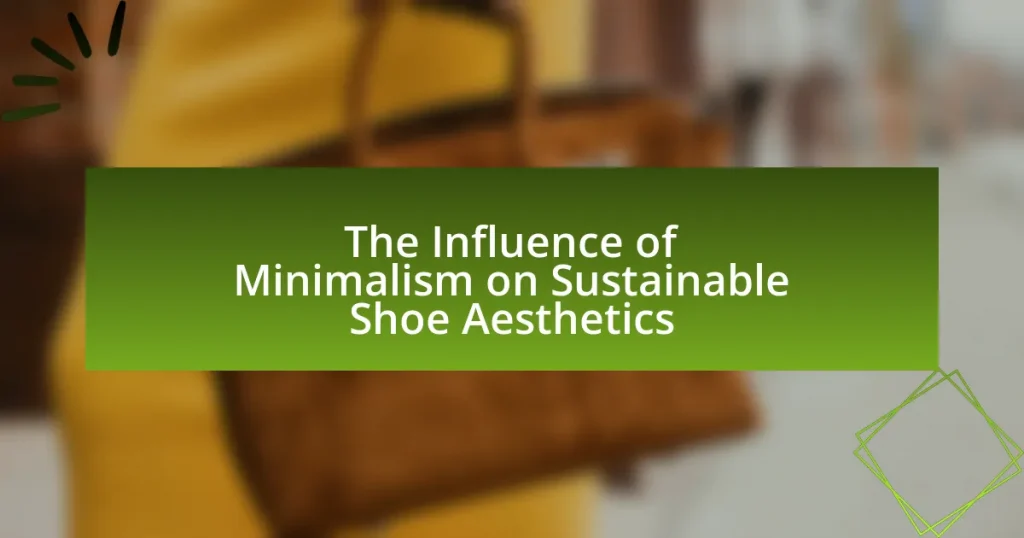Upcycled materials in luxury shoe design refer to repurposed materials salvaged from waste or discarded products, promoting sustainability within the fashion industry. This practice is increasingly adopted by brands like Stella McCartney and Gucci, who utilize materials such as leather scraps, textiles, rubber, and plastics to create high-quality footwear while reducing environmental impact. The article explores the definition, types, and importance of upcycled materials in luxury footwear, detailing the design processes, challenges faced by designers, and effective marketing strategies. Additionally, it examines future trends and innovations in upcycling, highlighting the role of technology and consumer responses to sustainable luxury fashion.

What are Upcycled Materials in Luxury Shoe Design?
Upcycled materials in luxury shoe design refer to repurposed materials that have been salvaged from waste or discarded products to create high-quality footwear. This practice not only reduces environmental impact but also promotes sustainability within the fashion industry. For instance, brands like Stella McCartney utilize upcycled textiles and leather scraps, demonstrating that luxury can coexist with eco-consciousness. The use of upcycled materials is supported by the growing consumer demand for sustainable fashion, with a report from McKinsey indicating that 67% of consumers consider sustainability when making a purchase.
How are upcycled materials defined in the context of luxury footwear?
Upcycled materials in the context of luxury footwear are defined as materials that have been repurposed from their original use to create new, high-quality products, enhancing both sustainability and design. This practice involves taking discarded or surplus materials, such as leather scraps or fabric remnants, and transforming them into fashionable footwear, thereby reducing waste and promoting environmental responsibility. The luxury footwear industry increasingly embraces upcycling as a means to align with consumer demand for sustainable practices, with brands like Stella McCartney and Gucci leading the way in integrating upcycled elements into their collections.
What types of materials are commonly upcycled for luxury shoes?
Commonly upcycled materials for luxury shoes include leather, textiles, rubber, and plastics. Leather, often sourced from discarded garments or furniture, is repurposed to create high-quality footwear. Textiles, such as vintage fabrics or surplus materials, are utilized to add unique designs and reduce waste. Rubber from old tires or footwear is transformed into durable soles, while plastics, including ocean waste, are reprocessed into stylish components. The use of these materials not only promotes sustainability but also enhances the uniqueness of luxury shoe designs.
Why is upcycling important in the luxury fashion industry?
Upcycling is important in the luxury fashion industry because it promotes sustainability and reduces waste while maintaining high-quality standards. The luxury sector, known for its resource-intensive production processes, faces increasing pressure to adopt environmentally friendly practices. Upcycling allows brands to transform discarded materials into new, desirable products, thereby minimizing the environmental impact associated with traditional manufacturing. For instance, according to a 2021 report by McKinsey & Company, the fashion industry is responsible for 2-8% of global greenhouse gas emissions, highlighting the urgent need for sustainable solutions. By integrating upcycled materials, luxury brands can enhance their appeal to environmentally conscious consumers, thereby aligning with market trends that favor sustainability.
What role do upcycled materials play in sustainable luxury fashion?
Upcycled materials play a crucial role in sustainable luxury fashion by reducing waste and promoting resource efficiency. The use of upcycled materials allows luxury brands to create high-quality products while minimizing their environmental impact, as it repurposes existing materials instead of relying on new resources. For instance, a study by the Ellen MacArthur Foundation highlights that upcycling can significantly decrease the carbon footprint associated with production processes, as it often requires less energy and fewer raw materials. This practice not only aligns with the growing consumer demand for sustainability but also enhances the uniqueness and storytelling aspect of luxury items, making them more appealing to environmentally conscious consumers.
How do upcycled materials contribute to reducing waste in the fashion industry?
Upcycled materials significantly reduce waste in the fashion industry by repurposing discarded textiles and materials into new products, thereby diverting them from landfills. This process not only minimizes the demand for virgin resources but also lowers the environmental impact associated with production and disposal. For instance, according to a report by the Ellen MacArthur Foundation, the fashion industry generates over 92 million tons of waste annually, and upcycling can effectively mitigate this by transforming waste into valuable items. By utilizing upcycled materials, brands can create unique, sustainable products while contributing to a circular economy that prioritizes resource efficiency and waste reduction.
What are the environmental benefits of using upcycled materials in shoe design?
Using upcycled materials in shoe design significantly reduces waste and conserves resources. By repurposing materials that would otherwise end up in landfills, the shoe industry minimizes its environmental footprint. For instance, a study by the Ellen MacArthur Foundation highlights that upcycling can reduce the demand for virgin materials, thereby lowering carbon emissions associated with production processes. Additionally, utilizing upcycled materials often requires less energy compared to traditional manufacturing, further contributing to a decrease in greenhouse gas emissions. This approach not only promotes sustainability but also encourages a circular economy, where materials are kept in use for as long as possible.

How are Upcycled Materials Integrated into Luxury Shoe Design?
Upcycled materials are integrated into luxury shoe design by repurposing discarded materials to create high-quality footwear that emphasizes sustainability and craftsmanship. Designers source materials such as vintage textiles, leftover leather, and industrial waste, transforming them into unique shoe components. For instance, brands like Stella McCartney and Balenciaga have successfully utilized upcycled plastics and fabrics, showcasing that luxury can align with eco-conscious practices. This approach not only reduces waste but also adds distinct character to each pair of shoes, appealing to environmentally aware consumers.
What design processes are involved in creating luxury shoes from upcycled materials?
The design processes involved in creating luxury shoes from upcycled materials include material sourcing, design conceptualization, prototyping, and production. Material sourcing focuses on identifying high-quality upcycled materials, such as discarded textiles or leather, which can maintain the luxury aesthetic. Design conceptualization involves sketching and planning the shoe’s style, ensuring it aligns with luxury standards while utilizing the unique characteristics of the upcycled materials. Prototyping is the next step, where initial designs are transformed into physical samples to evaluate fit, comfort, and visual appeal. Finally, production entails the careful crafting of the shoes, often involving skilled artisans who ensure that the final product meets luxury quality benchmarks. This process not only emphasizes sustainability but also showcases the potential of upcycled materials in high-end fashion.
How do designers source and select upcycled materials for their collections?
Designers source and select upcycled materials for their collections by identifying waste materials that can be repurposed into new products. They often collaborate with local businesses, textile manufacturers, and recycling centers to obtain discarded fabrics, leather scraps, and other materials that would otherwise contribute to landfill waste. For instance, brands like Stella McCartney have established partnerships with organizations that specialize in sourcing sustainable materials, ensuring that the upcycled components meet quality and aesthetic standards. This approach not only reduces environmental impact but also promotes creativity in design, as designers must innovate to incorporate these unique materials into their collections effectively.
What challenges do designers face when working with upcycled materials?
Designers face several challenges when working with upcycled materials, primarily related to material quality and consistency. Upcycled materials often vary significantly in durability, texture, and appearance, making it difficult for designers to ensure a uniform product. Additionally, sourcing these materials can be unpredictable, as availability depends on waste streams, which can fluctuate. This inconsistency can hinder the design process and complicate production timelines. Furthermore, designers must navigate the complexities of integrating upcycled materials into existing manufacturing processes, which may not be optimized for such materials, leading to increased costs and time.
How do luxury brands market their upcycled shoe collections?
Luxury brands market their upcycled shoe collections by emphasizing sustainability, exclusivity, and craftsmanship. They utilize storytelling to connect with consumers, highlighting the environmental benefits of upcycling and the unique narratives behind each collection. For instance, brands like Stella McCartney and Gucci showcase the innovative materials used and the artisanal processes involved, reinforcing their commitment to eco-friendly practices. Additionally, luxury brands leverage social media campaigns and collaborations with influencers to reach a broader audience, often featuring visually striking content that appeals to environmentally conscious consumers. This approach not only enhances brand image but also aligns with the growing consumer demand for sustainable fashion, as evidenced by a 2021 McKinsey report indicating that 67% of consumers consider sustainability when making a purchase.
What messaging strategies are effective in promoting sustainability in luxury footwear?
Effective messaging strategies for promoting sustainability in luxury footwear include emphasizing transparency, storytelling, and highlighting the use of upcycled materials. Transparency involves clearly communicating the sourcing and production processes, which builds trust with consumers. Storytelling connects emotionally with the audience by sharing the journey of the materials and the artisans involved, making the product more relatable. Highlighting the use of upcycled materials not only showcases innovation but also aligns with consumer values regarding environmental responsibility. For instance, brands like Stella McCartney have successfully utilized these strategies, resulting in increased consumer engagement and loyalty.
How do consumers respond to luxury shoes made from upcycled materials?
Consumers generally respond positively to luxury shoes made from upcycled materials, appreciating the blend of sustainability and high-end fashion. This positive response is driven by a growing awareness of environmental issues and a desire for ethical consumption, with studies indicating that 66% of global consumers are willing to pay more for sustainable brands. Additionally, luxury brands that utilize upcycled materials often attract a younger demographic, particularly millennials and Gen Z, who prioritize sustainability in their purchasing decisions. This trend is supported by market research showing that brands like Stella McCartney and Veja have successfully integrated upcycled materials, leading to increased sales and brand loyalty among eco-conscious consumers.

What are the Future Trends in Upcycled Materials for Luxury Shoe Design?
Future trends in upcycled materials for luxury shoe design include the increased use of innovative textiles derived from post-consumer waste, such as recycled plastics and discarded fabrics. Brands are focusing on sustainability by integrating these materials into high-end designs, reflecting a growing consumer demand for eco-friendly products. For instance, a report by McKinsey & Company highlights that the luxury fashion market is increasingly prioritizing circular economy principles, with upcycled materials expected to play a significant role in reducing environmental impact. Additionally, collaborations between luxury brands and sustainable material innovators are likely to rise, further enhancing the aesthetic and functional qualities of upcycled footwear.
How is technology influencing the use of upcycled materials in shoe design?
Technology is significantly enhancing the use of upcycled materials in shoe design by enabling innovative processes and improving material performance. Advanced techniques such as 3D printing allow designers to create intricate shoe components from upcycled materials, which can reduce waste and lower production costs. Additionally, technologies like computer-aided design (CAD) facilitate the precise manipulation of these materials, ensuring that they meet the aesthetic and functional requirements of luxury footwear. For instance, brands like Adidas have utilized upcycled ocean plastic in their shoes, demonstrating how technology can transform waste into high-quality products while promoting sustainability.
What innovations are emerging in the upcycling process for luxury footwear?
Innovations in the upcycling process for luxury footwear include the use of advanced materials such as bio-based leathers, recycled plastics, and innovative textile blends. Brands are increasingly adopting techniques like laser cutting and 3D printing to minimize waste and enhance design flexibility. For instance, companies like Stella McCartney are utilizing mycelium-based materials, which are sustainable and biodegradable, while others are incorporating post-consumer waste into their products, significantly reducing their environmental footprint. These advancements not only improve sustainability but also allow for unique aesthetic expressions in luxury footwear design.
How can brands leverage consumer trends towards sustainability in their designs?
Brands can leverage consumer trends towards sustainability in their designs by incorporating upcycled materials into their products. This approach not only aligns with the growing consumer demand for environmentally friendly options but also reduces waste and resource consumption. For instance, a study by McKinsey & Company found that 66% of consumers are willing to pay more for sustainable brands, indicating a strong market for products that prioritize eco-friendliness. By utilizing upcycled materials, brands can enhance their appeal to this demographic while also contributing to a circular economy, which is increasingly valued by consumers.
What best practices should designers follow when using upcycled materials?
Designers should prioritize quality and functionality when using upcycled materials. Ensuring that the upcycled components are durable and suitable for the intended use is crucial, as this maintains the integrity of the final product. Additionally, designers should conduct thorough research on the source of the materials to verify their sustainability and environmental impact. For instance, using materials that have been responsibly sourced can enhance the overall value of the design. Furthermore, designers should embrace creativity by innovatively integrating upcycled materials into their designs, which can lead to unique and marketable products. This approach not only promotes sustainability but also aligns with consumer demand for eco-friendly fashion.
How can designers ensure quality and durability in upcycled luxury shoes?
Designers can ensure quality and durability in upcycled luxury shoes by selecting high-quality materials and employing rigorous craftsmanship techniques. By sourcing premium upcycled materials, such as high-grade leather or durable textiles, designers can enhance the longevity of the shoes. Additionally, implementing advanced construction methods, like reinforced stitching and proper sealing, contributes to the overall durability. Research indicates that luxury brands that focus on meticulous quality control and sustainable sourcing practices, such as Stella McCartney, have successfully created long-lasting products while maintaining their luxury appeal.
What are the key considerations for maintaining brand identity while using upcycled materials?
Maintaining brand identity while using upcycled materials requires a clear alignment between the brand’s core values and the sustainable practices adopted. Brands must ensure that the upcycled materials reflect their aesthetic and quality standards, as seen in luxury markets where craftsmanship is paramount. For instance, brands like Stella McCartney successfully integrate eco-friendly materials without compromising their luxury appeal, demonstrating that sustainability can coexist with high-end design. Additionally, effective storytelling about the sourcing and transformation of upcycled materials can enhance brand authenticity and resonate with consumers who value sustainability, as evidenced by a 2021 study from McKinsey, which found that 67% of consumers consider sustainability when making luxury purchases.



